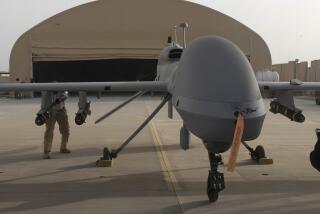U.S. Bidding to Regain Missiles Sent to Afghans
- Share via
WASHINGTON — Partly in response to growing fears of terrorist attacks on American civilian aircraft, the CIA this month requested $55 million to buy back hundreds of the highly efficient Stinger antiaircraft missiles that the United States gave to Afghan rebels in the 1980s, according to informed U.S. sources.
The extraordinary sum--more than five times the last allocation for the covert Stinger buyback program--was sought by the Clinton Administration from contingency funds because of fierce competition on the international black market for the prized missiles, according to knowledgeable sources.
U.S. agents have been finding themselves outbid for the accurate, shoulder-launched rockets that now fetch upward of $100,000 apiece on the black market, officials said. The weapons originally cost $25,000 to $30,000 each.
“Whatever we pay to get them back is a small price, given the almost insoluble threat to civil aviation that Stingers in the hands of terrorists pose,” said Bruce Hoffman, a terrorism expert at the RAND think tank in Santa Monica.
Since the end of Soviet occupation in 1989, Washington has feared that the Stingers might fall into the hands of either foreign extremists or hostile governments. After Afghan guerrillas ousted the Communist government in Kabul in the spring of 1992, the CIA launched a secret effort to recover the heat-seeking missiles with help from Pakistan.
Several Western intelligence agencies are also now cooperating in the effort, one of the most significant and costly attempts to tie up a messy and potentially disastrous remnant of the Cold War. Stingers are light enough to be fired from the shoulder but are powerful enough to bring down an airliner.
At a cost of at least $30 million, the United States gave roughly 1,000 Stingers to the Afghan moujahedeen in the mid- and late-1980s to combat the Soviet occupation force and its surrogate government in Kabul.
Stingers were particularly effective against Soviet helicopter gunships during the decade-long occupation. Estimates vary, but up to about 250 may have been used, the sources said.
The CIA originally hoped to secure the Stingers in exchange for humanitarian supplies or postwar reconstruction material, although various offers were all spurned.
During the George Bush Administration, the CIA requested and was granted $10 million for Operation MIAS (for “missing-in-action Stingers”), but the sum proved insufficient as the price of the weapons rose on the open market, the sources said.
Since February, the World Trade Center bombing and the discovery of an alleged plot to bomb New York tunnels and the United Nations have heightened concern about innovative new twists to anti-American terrorism by Muslim extremists. In both incidents, at least one suspect had trained with or had links to the Afghan resistance.
Iran also is believed to have acquired Stingers, possibly by buying them from Afghans and by confiscating them from Afghan rebels who strayed across the Afghan-Iranian border.
The CIA buybacks have been frustrated by a bidding war that continues to drive up prices. Rival Afghan militia commanders also have been reluctant to sell the weapons, which are a status symbol as well as a source of badly needed income in a poor country further devastated by 14 years of civil war.
The Stingers have become part of Afghan postwar lore. Stories abound of guerrillas toting their Stingers by camel or donkey to offer them at extraordinary prices to bidders ranging from Arab extremists to Western diplomats.
CIA officials reportedly still are not prepared to ensure that they will be able to acquire all the weapons, even with the new funding. Hoffman said the United States is unlikely to recover all or even most of the missiles because of the intense competition.
“Whoever has the most money is going to get them,” Hoffman said. “They’re highly desirable--the state-of-the-art, lightweight surface-to-air missile.”
He said terrorist groups and the governments that support them will pay large sums to acquire such weapons because it is becoming increasingly difficult to threaten aircraft with hijacking or bombings.
“They’re turning to the only practical means available to them--and that’s precisely the Stinger and similar weapons,” Hoffman said.
Even if the United States can recover many of the missiles, new versions from other countries are likely to flood into the market. Britain, Russia and France already produce similar missiles, and China, Sweden, South Africa, Brazil and Egypt are developing or already marketing Stinger look-alikes.
Hoffman said the Irish Republican Army has acquired from Libya “at least a dozen” Soviet-made SAM-7s, which are very similar to the Stinger. He said IRA commandos have downed at least one British army helicopter with the missiles.
Guerrilla groups in Sudan and Rhodesia (now Zimbabwe) have used similar weapons from the Soviet Union to bring down civilian airliners.
More to Read
Sign up for Essential California
The most important California stories and recommendations in your inbox every morning.
You may occasionally receive promotional content from the Los Angeles Times.













